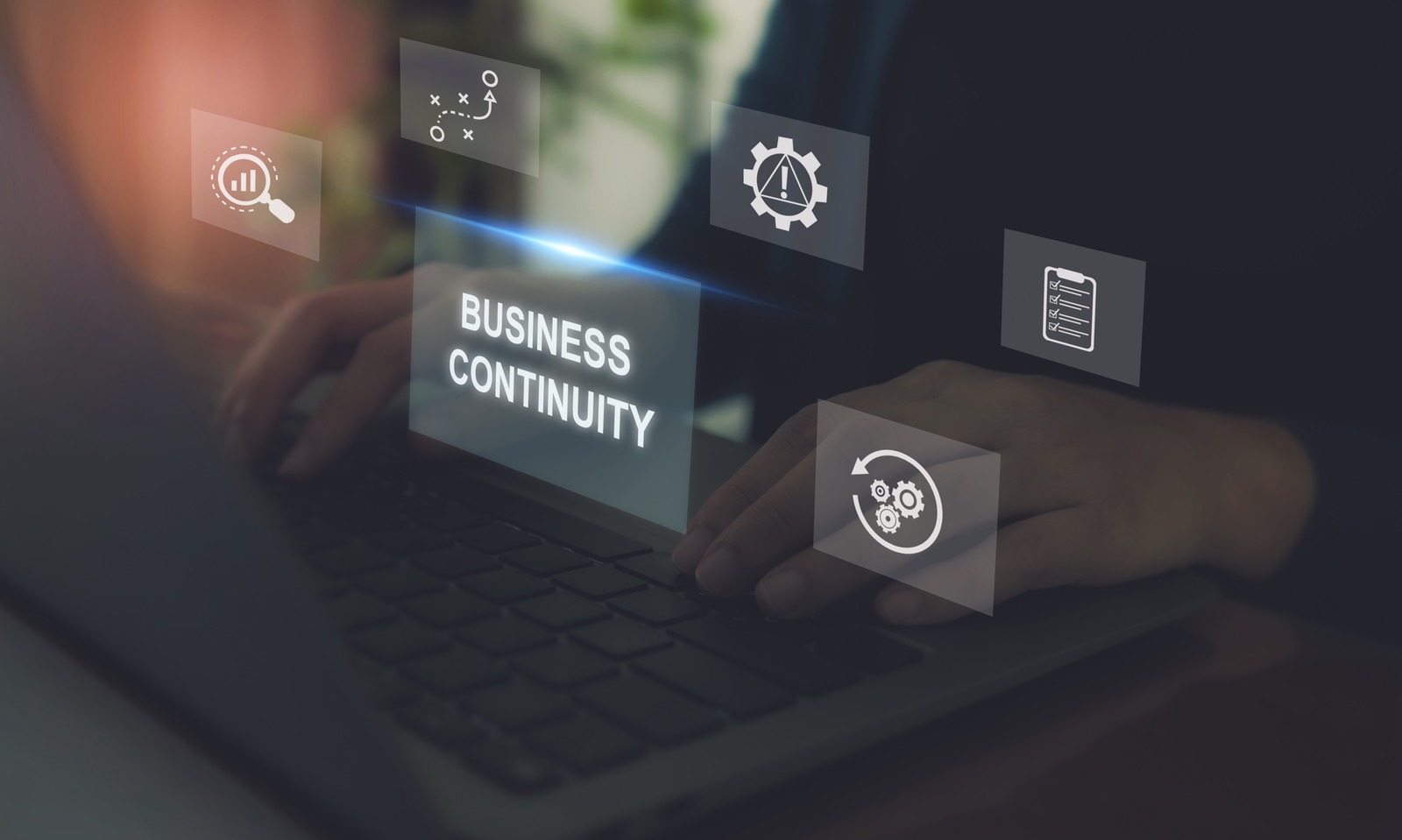Your business must be prepared to weather any storm that comes its way, whether it’s a cyberattack, global pandemic, or a literal storm. While both business continuity and disaster recovery plans are critical components of a risk management framework, they address different aspects of your organizational resilience. Understanding the differences between these two approaches is a must for developing a strategy that protects your business from all angles.
Read on to explore the key differences between business continuity and disaster recovery and how these strategies work together to keep your organization running smoothly, no matter what challenges you face.
Why Are Business Continuity and Disaster Recovery Important?
The list of potential risks businesses face is extensive, from sophisticated cyberattacks and power outages to natural disasters and global health crises. Without proper planning, these events can have devastating consequences for your organization.
Consider the financial losses alone: the average cost of downtime can range from $427 to $9,000 per minute, depending on the size of the business.1 This doesn’t even account for the long-term damage to your reputation, customer relationships, and market position that can result from a prolonged disruption.
Three main areas of concern for businesses are:
- Cyberattacks: With the rise of ransomware, data breaches, and other malicious activities, businesses must be prepared to defend against and recover from digital threats quickly and effectively. An effective disaster recovery plan can be the difference between a minor setback and catastrophic data loss.
- Network Outages: Network outages, whether caused by technical failures or human error, can bring your business operations to a standstill. A business continuity plan should include strategies for identifying the source of network issues, implementing redundant systems, and maintaining critical operations even when your primary networks are down.
- Physical Disasters: A natural disaster like a fire, earthquake, or flood can damage infrastructure, disrupt supply chains, and render workspaces unusable. A business continuity plan ensures your company has alternative processes in place to maintain your essential functions when your main facilities are compromised.
By investing in both business continuity and disaster recovery planning to address these areas, you’re not just protecting your assets – you’re safeguarding your entire organization’s future. These strategies provide a roadmap for navigating disruptions, limiting downtime, and emerging stronger on the other side of any disaster.
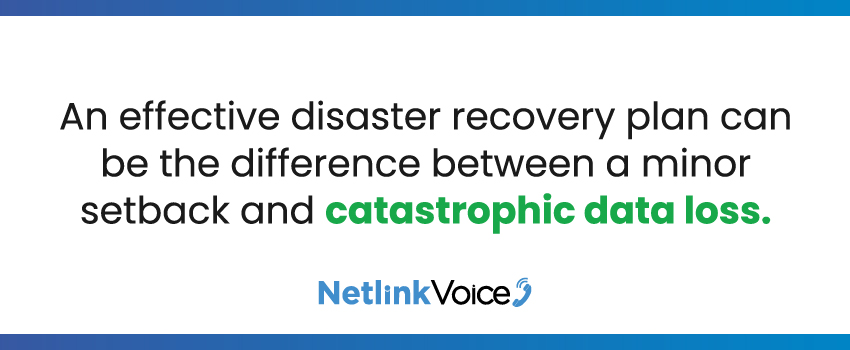
What Is Business Continuity Planning?
Business continuity planning (BCP) is a proactive approach to ensuring critical functions can keep operating during and after a catastrophic event. It’s a strategy that looks at your organization as a whole to identify the processes, resources, and dependencies that are essential for maintaining operations.
While building a business continuity plan will look different for each company, you’ll likely follow a few basic steps:
1. Conduct a Risk Assessment
Identify potential threats to your organization by conducting a thorough analysis of the factors that could disrupt your business, such as physical disasters, cyberattacks, supply chain disruptions, or even personnel departures.
2. Run a Business Impact Analysis
Once you’ve identified potential risks, the next step is to determine how these disaster scenarios would affect your business operations. A business impact analysis (BIA) can help you quantify the potential losses associated with various disruptive events so you can prioritize your recovery efforts.
3. Develop Responses
Now that you have a clear understanding of your risks and potential impacts, you can develop specific strategies to maintain or resume your business functions if a disaster occurs. This might include determining alternate work locations, cross-training employees, or implementing redundant systems for important business processes.
4. Assign Roles and Responsibilities
Successful business continuity plans depend on clear leadership and well-defined responsibilities. Identify the employees who will need to implement each aspect of the plan and make sure they have the necessary authority and resources to act quickly in a crisis.
5. Create and Rehearse Plan
Document your business continuity strategies in a clear, accessible format and distribute them to your relevant stakeholders. Conducting regular tests and rehearsals can help ensure your plan stays effective and that all team members understand their roles in executing it.
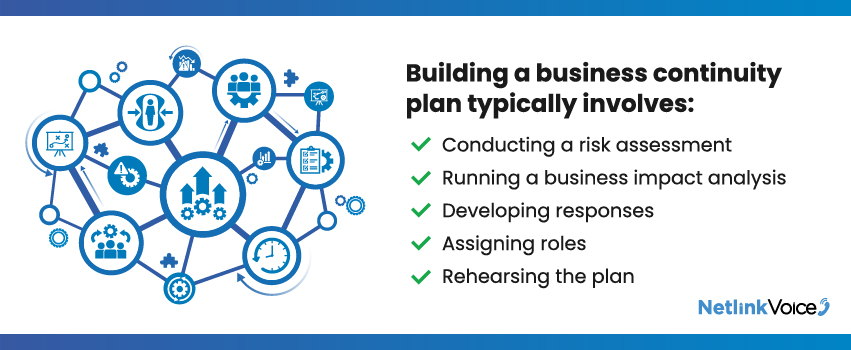
What Is Disaster Recovery Planning?
Business continuity planning takes a broad view of organizational resilience, but disaster recovery planning (DRP) focuses specifically on restoring IT systems and lost data after a disruptive event. A disaster recovery plan is a critical component of your overall business continuity strategy, ensuring that the technological backbone of your organization can be quickly restored to resume operations.
Some steps to developing a disaster recovery plan include:
1. Determine Critical IT Needs
First, identify the IT systems and data you need for your business operations. This includes not just software and hardware but also the networks, databases, and apps that your teams rely on daily for their work.
2. Inventory Assets
Create a complete inventory of all your IT assets, including servers, workstations, network devices, and software licenses. This inventory should also include information about your organization’s specific configurations, dependencies, and recovery priorities.
3. Assign Roles and Responsibilities
As with business continuity plans, clear leadership is vital for developing an effective disaster recovery plan. Designate specific team members to oversee the various aspects of the recovery process, such as restoring data, rebuilding systems, and communicating with business leaders.
4. Create and Rehearse Plan
Document your disaster recovery plans in detail, including step-by-step instructions to restore data and critical systems. Conduct regular testing and simulations to ensure your disaster recovery team can execute the plan effectively under pressure and recover all systems within your defined recovery time objectives (RTOs) and recovery point objectives (RPOs).
Business Continuity vs. Disaster Recovery: Compared
Business continuity and disaster recovery planning share some common elements, but they are distinct strategies with different focuses and objectives. Here’s how business continuity vs. disaster recovery strategies differ:
Focus
Business continuity focuses on maintaining your critical business functions during and after a disruption. They consider all aspects of operations, from supply chain management to customer service, to ensure your business can continue to deliver value even in challenging circumstances. Planning your business continuity strategy can help you identify and prioritize essential processes to minimize disruptions and their impact on your business.
Disaster recovery focuses specifically on restoring your technological infrastructure as quickly as possible. Planning for disaster recovery involves creating detailed strategies for backing up data, replicating systems, and restoring IT services to maintain business functionality in the event of network failures or cyberattacks.
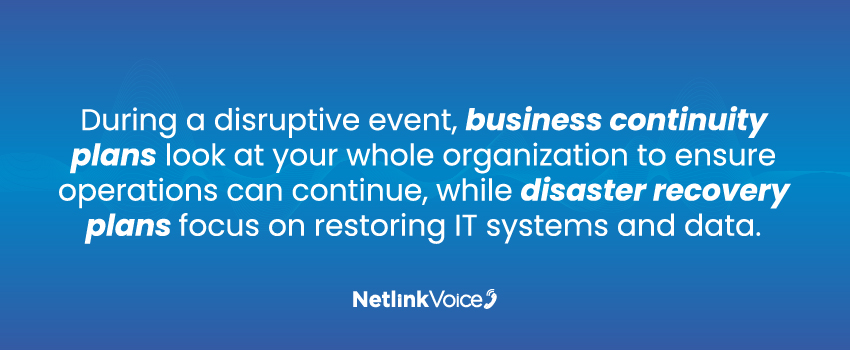
Goals
The primary goal of a business continuity plan is to keep your business running with minimal disruption to your customers, employees, and stakeholders. Business continuity planning aims to ensure your organization can adapt to changing circumstances and keep meeting its objectives, even during challenges.
Disaster recovery plans aim to recover IT systems and data to a working state within predefined time frames. The goal is to minimize data loss and system downtime so that your critical technology resources are available to support business operations as quickly as possible after an emergency event. This includes setting a recovery time objective and recovery point objective for your systems and applications, as well as prioritizing the most important resources for fast restoration.
Scope
Business continuity plans encompass all aspects of your organization, including your employees, facilities, supply chain, and customer relationships. They consider interdependencies between different business units and processes to ensure all critical elements are protected and can still function during a disruption.
Disaster recovery plans are primarily concerned with your IT infrastructure, including hardware, software, data, and network resources. They involve detailed technical considerations like data backup strategies, system redundancy, and failover procedures, as well as close collaboration between your IT teams and other departments to understand the technology needs and recovery priorities of different business units.
Timeframe
Business continuity addresses both short-term crisis management and long-term strategies for staying operational. Short-term measures might include activating your emergency response teams or implementing temporary workarounds, while long-term strategies could involve diversifying your supply chains or developing flexible work policies.
Since disaster recovery plans provide immediate response and short-term recovery of your IT systems, they often involve a phased approach where your most critical processes are restored first, followed by less essential resources. While the immediate focus is on fast recovery, a disaster recovery plan should also consider longer-term strategies to improve system resilience and reduce the risk of future disruptions.
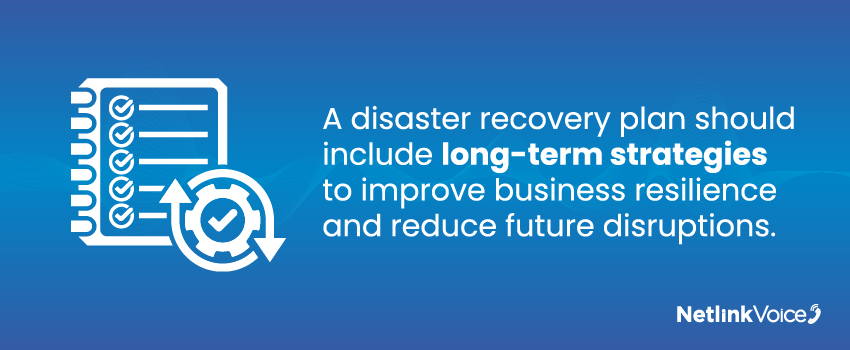
Planning Process
Business continuity planning involves a wide range of stakeholders from across your business, including executives, department heads, and personnel from various business units. The planning process often involves extensive risk assessments, business impact analyses, and scenario planning to develop proactive strategies for maintaining operations under different conditions.
IT teams often lead disaster recovery planning with input from other departments regarding their technology needs and recovery priorities. IT teams work closely with business units to establish recovery objectives, develop recovery procedures, and ensure the disaster recovery plan aligns with overall business continuity goals.
Implementation
Implementing a business continuity plan will look different depending on your specific needs. It may involve activating an alternate location, implementing manual processes, or diverting resources to maintain operations. This often demands significant coordination and flexibility, as your teams may need to quickly adapt to new circumstances.
Implementing a disaster recovery plan typically includes processes like data restoration, system reconfiguration, or even setting up temporary IT environments to support your critical business functions while full recovery is in process. This requires a high level of technical expertise and involves following detailed, step-by-step procedures to restore your IT services.
Metrics
The effectiveness of a business continuity plan is measured by your organization’s ability to maintain operations and meet customer needs during a disruption. Key performance indicators might include customer satisfaction levels, financial performance during and after the crisis, or the speed at which your normal operations are restored.
Disaster recovery focuses on recovery time objectives, which measure how quickly your IT teams can restore systems to functionality, and recovery point objectives, which indicate the maximum acceptable amount of data loss.
Boost Your Business Continuity and Disaster Recovery With Netlink Voice
Putting robust business continuity and disaster recovery plans in place is essential for safeguarding your operations, reputation, and bottom line. These strategies work together to help your business get through any crisis, from cyber attacks and network outages to natural disasters and beyond.
Need expert help developing your business continuity and disaster recovery plans? Netlink Voice offers vulnerability assessments and penetration testing to make sure your systems are secure – and stay that way. Plus, we provide cybersecurity solutions to protect your data and network, backed by proactive monitoring from our 24/7/365 security operations center. Reach out to the Netlink Voice team today to get started.
Sources:

